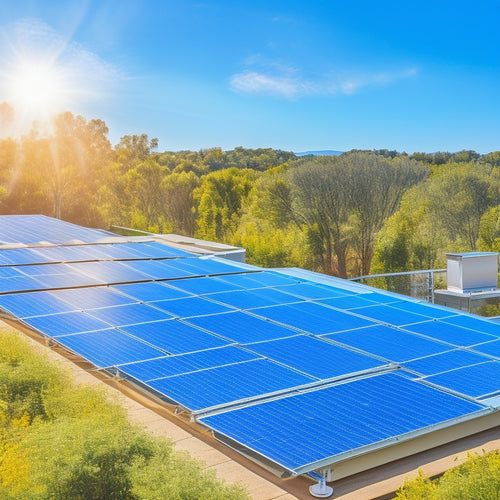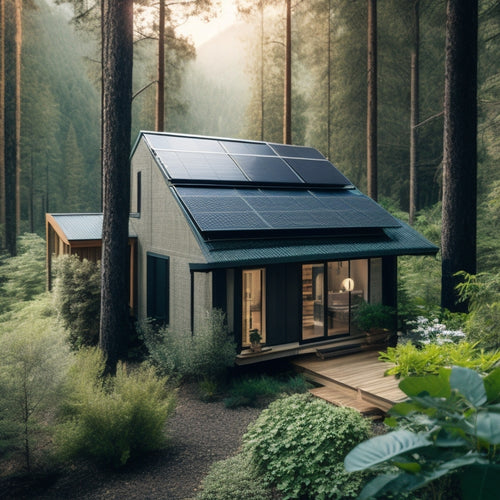
5 Tips for Solar System Maintenance
Share
To enhance your solar system's performance, you'll want to schedule regular system checks, cleaning your panels quarterly to maintain maximum efficiency. Monitor your system's performance and analyze data to identify potential issues, inspecting and replacing worn parts promptly. Perform seasonal adjustments to guarantee optimal energy production, considering factors like weather conditions and panel angle. By following these tips, you'll be well on your way to extending your system's lifespan and maximizing its energy output. Now, explore the specifics of each step to access the full potential of your solar system.
Overview
- Conduct regular system checks quarterly to identify issues and prevent performance degradation.
- Clean solar panels regularly to maintain maximum energy output, improving efficiency by up to 25%.
- Monitor performance data to track key indicators like energy output, voltage, and temperature.
- Inspect and replace worn parts promptly to ensure peak energy production and prevent further damage.
- Perform seasonal system adjustments to optimize energy production and protect against harsh weather conditions.
Schedule Regular System Checks
Each quarter, set aside a few hours to inspect your solar system's performance and identify potential issues before they escalate into major problems.
Regular system checks are vital to guarantee your solar system operates at its best, maximizing energy production and system longevity.
It's important to monitor your battery's state of charge (SOC) and depth of discharge (DOD) regularly, as recommended in battery monitoring, to prevent overcharging and undercharging.
During these checks, review your system's performance data, inspect for signs of wear and tear, and verify that all components are functioning correctly.
Consider hiring a professional to perform inspections annually to catch any potential issues that may have been missed.
Clean Panels for Maximum Efficiency
Maintaining a clean solar panel surface is essential for ideal energy harvesting, as dirt, grime, and other obstructions can greatly reduce your system's power output.
You'll want to adopt effective panel cleaning techniques to guarantee maximum energy production. Start by inspecting your panels regularly for dirt and debris accumulation. According to experts, regular cleaning can improve energy output by up to 25% Clean Panels for Maximum Energy.
Use gentle dirt removal methods, such as soft-bristled brushes or microfiber cloths, to wipe away loose particles. For more stubborn grime, mix a solution of mild soap and water, and use a soft-bristled brush to gently scrub the panels.
Rinse thoroughly with clean water to prevent streaks and mineral deposits. By incorporating regular cleaning into your maintenance routine, you'll optimize your system's performance and enjoy the freedom that comes with reliable, renewable energy.
Monitor Performance and Analyze Data
Three key performance indicators (KPIs) to track in your solar system's monitoring data are energy output, voltage, and temperature. These metrics provide significant understandings into your system's overall health and efficiency. By regularly reviewing these KPIs, you can identify potential issues before they become major problems, ensuring your system runs at peak performance.
| KPI | Optimal Range |
|---|---|
| Energy Output | 90-100% of rated capacity |
| Voltage | 380-420 VDC |
| Temperature | 25-40°C (77-104°F) |
| Daily Energy Yield | 4-6 kWh/kWp |
| Inverter Efficiency | 95-98% |
Inspect and Replace Worn Parts
As you've been monitoring your solar system's performance and analyzing the data, you're likely to identify areas that require attention.
Inspect your system's components, looking for signs of wear and tear, such as corrosion, loose connections, or damaged panels. Regular maintenance is vital to prevent capacity fade and extend the lifespan of your solar batteries Understanding Battery Lifespan.
Troubleshoot issues by checking for faulty inverters, optimizers, or other components that may be affecting system performance. It's important to replace worn parts promptly to guarantee peak energy production and prevent further damage.
Consider upgrading components to more efficient or durable alternatives to future-proof your system. By staying on top of maintenance, you'll enjoy a reliable and efficient solar system that provides the freedom and independence you desire.
Perform Seasonal System Adjustments
When seasonal changes impact the angle and intensity of sunlight, your solar system's performance can suffer. To guarantee peak energy production, you'll need to perform seasonal system adjustments.
Start by conducting seasonal inspections to identify any potential issues. Consider weather conditions like snow, leaves, or debris that may obstruct your panels.
Adjust your system's tilt and angle to compensate for the changed sunlight angle. This will help maximize energy production during the winter months.
Additionally, inspect your system's wiring and connections to verify they're secure and protected from harsh weather conditions.
Frequently Asked Questions
Can I Use a Pressure Washer to Clean My Solar Panels?
When cleaning solar panels, you'll want to avoid using a pressure washer, as high pressure can damage the panels' surface. Instead, opt for gentle cleaning techniques, and if you must use a pressure washer, take precautions to maintain a safe distance and low pressure.
How Often Should I Inspect My System's Electrical Connections?
When sailing, a single loose rope can capsize the entire ship; similarly, one corroded electrical connection can cripple your solar system. You should inspect your connections quarterly, performing voltage testing to guarantee peak performance and prevent connection corrosion from silently draining your energy freedom.
What Is the Ideal Temperature for Solar Panel Operation?
You optimize solar panel efficiency by operating them within the ideal temperature range of 59°F to 95°F (15°C to 35°C), as temperatures above or below this range can negatively impact performance, reducing energy output by up to 0.5% per degree Celsius.
Can I Install Solar Panels on a Metal Roof?
You can install solar panels on a metal roof, leveraging its benefits like durability and weather-tightness, but consider factors like panel weight, roof slope, and attachment methods to guarantee a secure and ideal installation.
Are Solar Panels Resistant to Hail and Extreme Weather?
Imagine golf-ball-sized hail pounding your solar panels - but don't worry, you're protected! You'll find that most modern solar panels are designed to withstand hail damage and extreme weather conditions, ensuring their weather durability and your freedom from energy woes.
Ready to Buy
As you steer through the cosmos of solar system maintenance, remember that a well-tended garden of panels is like a harmonious orchestra - each component working in concert to produce a melody of efficiency. By following these 5 tips, you'll be the maestro of your solar system, ensuring it runs at peak performance and yields a bountiful harvest of clean energy. Neglect these tasks, and your system will wither like an untended garden, its potential unfulfilled.
Related Posts
-

What Types of Solar Energy Devices Are Available
You'll find several types of solar energy devices available today, each customized to different energy needs. Photovo...
-

Top Off Grid Solar Batteries for Renewable Energy
When seeking top off-grid solar batteries for renewable energy, consider options with advanced battery chemistry, suc...
-

Off Grid Solar Batteries
As you shift to off-grid living, you'll rely on high-performance solar batteries to store excess energy generated by ...


